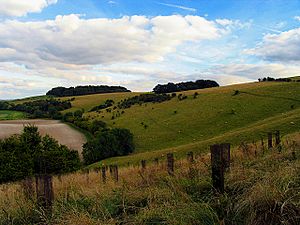West Woodhay Down facts for kids
| Site of Special Scientific Interest | |
 |
|
| Area of Search | Berkshire Hampshire |
|---|---|
| Interest | Biological |
| Area | 1.5 hectares (3.7 acres) |
| Notification | 1985 |
| Location map | Magic Map |
West Woodhay Down is a really special place in nature, located in both Berkshire and Hampshire, England. It's protected because it's home to unique plants and habitats. Imagine a beautiful hillside where rare flowers grow! This area is a "Site of Special Scientific Interest," or SSSI for short. This means it's one of the best places in the country for wildlife and geology.
West Woodhay Down: A Special Place for Nature
What is West Woodhay Down?
West Woodhay Down covers about 1.5 hectares, which is roughly the size of two football fields. It was officially recognized as a Site of Special Scientific Interest in 1985. This means it's a very important area for nature and is legally protected. It's located near the village of West Woodhay, west of the town of Newbury.
This special area used to be part of a larger protected site called the Inkpen and Walbury Hills SSSI. West Woodhay Down is mostly a type of habitat called "lowland Calcareous grassland". This means it's a grassy area on chalky or limestone soil. The soil is rich in calcium, which helps certain kinds of plants to grow very well. This particular grassland has a bank that faces northwest.
Amazing Plants You Can Find Here
West Woodhay Down is famous for its incredible variety of plants. Many of these plants thrive in the special chalky soil found here. Some are quite rare or important for the local ecosystem. Here are some of the interesting plants you might discover:
- Bromus erectus (Upright Brome): A common grass found in chalk grasslands.
- Blackstonia perfoliata (Yellow-wort): A bright yellow flower that loves sunny, chalky spots.
- Leontodon autumnalis (Autumn Hawkbit): A yellow, dandelion-like flower that blooms in autumn.
- Linum catharticum (Purging Flax): A delicate white flower often found in grasslands.
- Galium cruciata (Crosswort): A plant with small yellow-green flowers.
- Asperula cynanchica (Squinancywort): A small plant with tiny pinkish-white flowers.
- Primula veris (Cowslip): A beautiful yellow flower, often seen in spring.
- Scabiosa columbaria (Small Scabious): A pretty purple flower that attracts butterflies.
- Reseda lutea (Wild Mignonette): A plant with tall spikes of yellowish-green flowers.
- Sanguisorba minor (Salad Burnet): A plant with small, reddish-brown flower heads.
- Gymnadenia conopsea (Fragrant Orchid): A lovely orchid with pink or purple flowers that smell sweet.
- Anacamptis pyramidalis (Pyramidal Orchid): Another beautiful orchid with a pyramid-shaped cluster of pink flowers.
- Helianthemum nummularium (Common Rock-rose): A bright yellow flower that grows close to the ground.
- Centaurea scabiosa (Greater Knapweed): A tall plant with large, purple thistle-like flowers.
- Campanula rotundifolia (Harebell): A delicate blue bell-shaped flower.
- Listera ovata (Common Twayblade): An orchid with two large, oval leaves.
- Herminium monorchis (Musk Orchid): A small, green orchid known for its musky scent.
- Coeloglossum viride (Frog Orchid): A small, green orchid that can be hard to spot.
- Polygala calcarea (Chalk Milkwort): A small plant with bright blue flowers that loves chalky soil.
- Saxifraga granulata (Meadow Saxifrage): A white-flowered plant that grows in grassy areas.
- Crataegus (Hawthorn): A thorny shrub or small tree with white flowers and red berries.
- Whitebeam: A tree with distinctive silvery-white leaves.
- Crataegus monogyna (Common Hawthorn): The most common type of hawthorn.
These plants make West Woodhay Down a truly special place for nature lovers and scientists alike!

